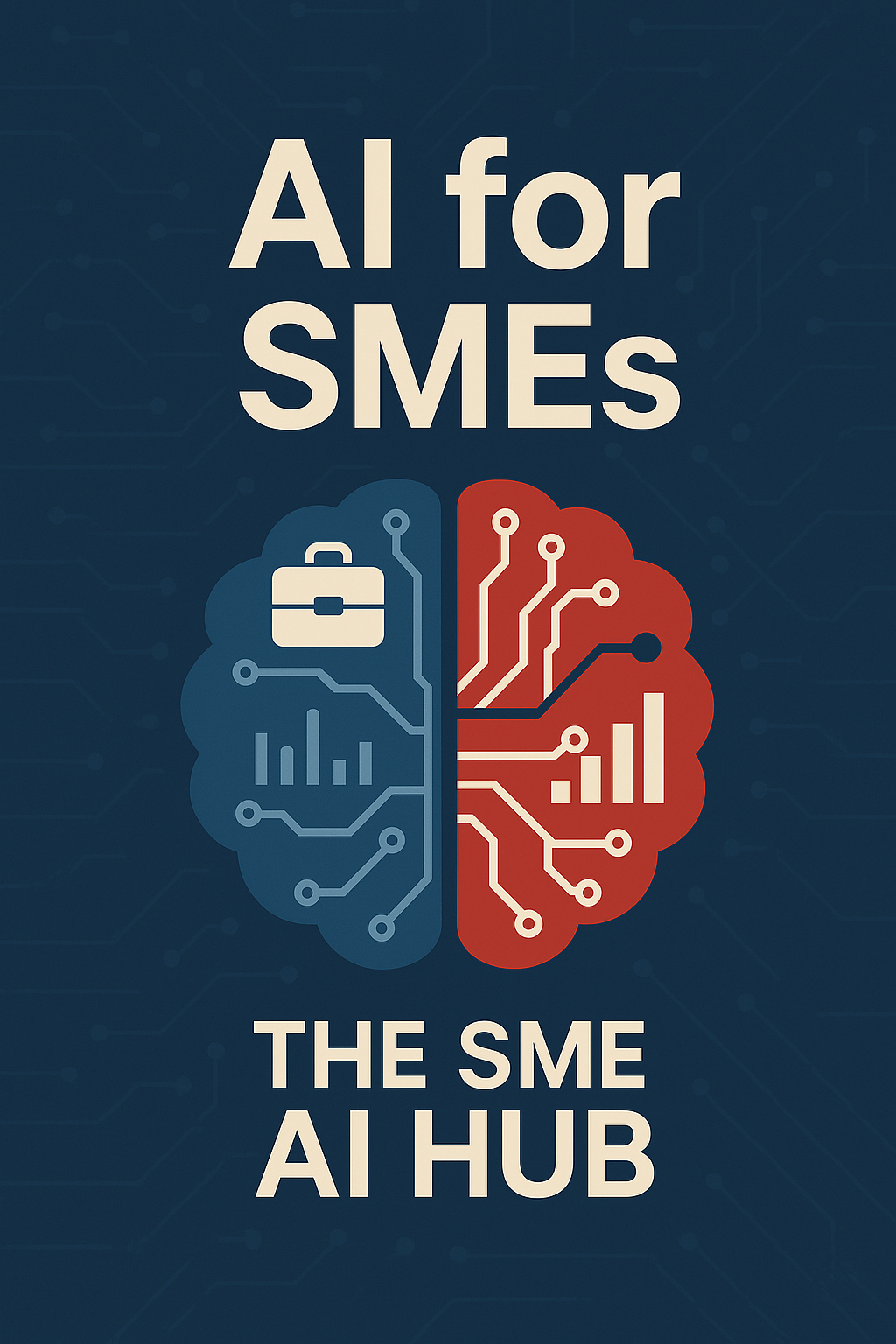Demystifying AI: What UK SMEs Need to Know (And Do) in 2025.
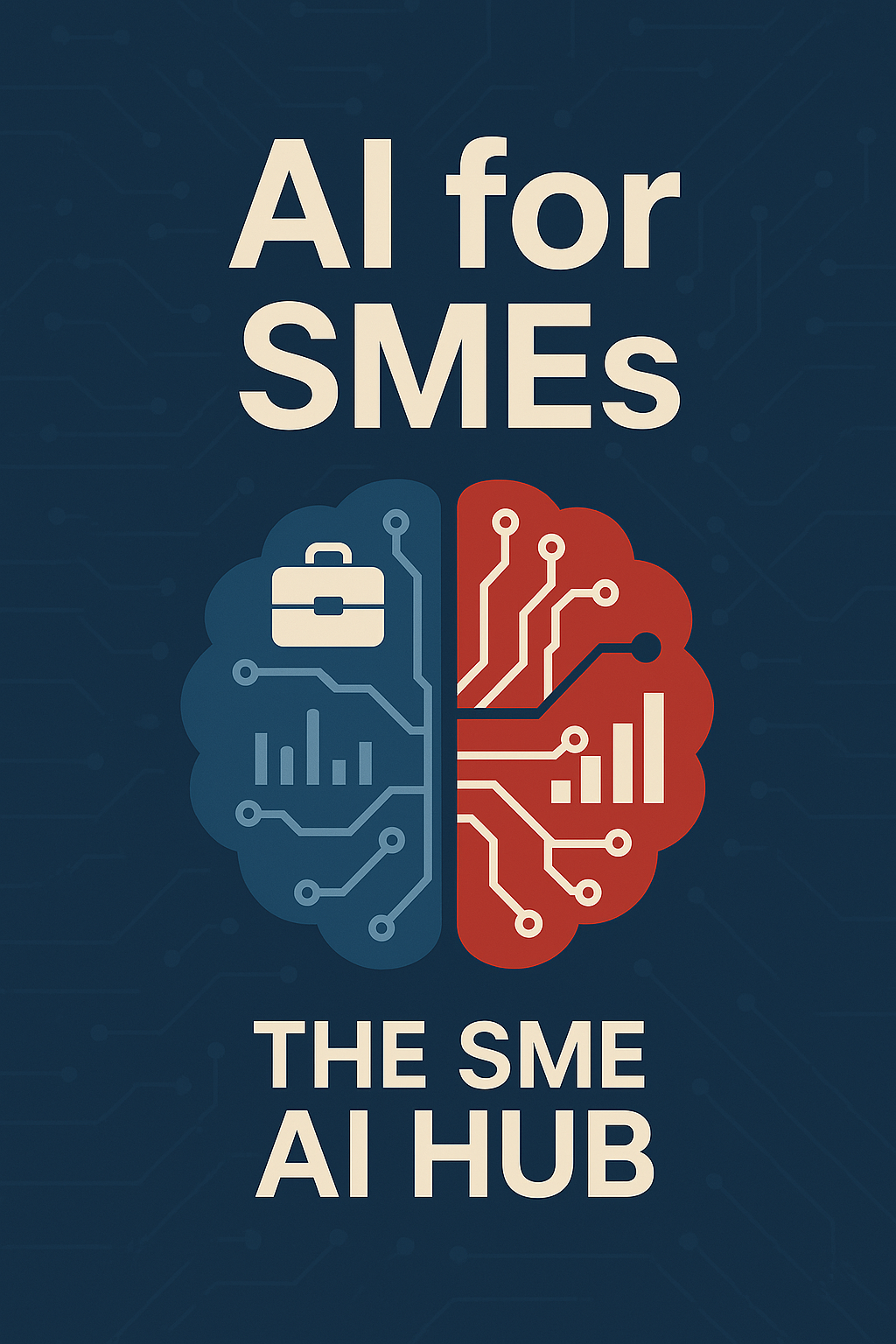
Before diving in, let's set the scene. Artificial Intelligence (AI) is no longer just a buzzword discussed in tech hubs; it's a practical toolset transforming businesses of all sizes, right here in the UK. You've likely heard the hype, maybe felt a bit overwhelmed, or wondered if it's even relevant for your SME. The good news? AI is more accessible and useful than ever, especially for smaller businesses looking to gain an edge. This post, alongside our latest podcast episode, cuts through the noise to give you a clear understanding of what AI means for your business in 2025 and how you can start using it effectively.
🧠 1. AI—What It Actually Is (No Jargon, Promise)
Let’s cut through the hype and talk business reality. At its core, Artificial Intelligence (AI) involves machines designed to simulate human thinking processes – things like learning from experience, reasoning through problems, making predictions, and deciding on actions.
For your SME in 2025, it's about smart software tools designed to automate tasks, uncover insights, and ultimately help your business operate more efficiently and effectively. Think of it as getting a super-powered assistant for specific jobs.
Let’s break it down - AI essentially has three pillar.
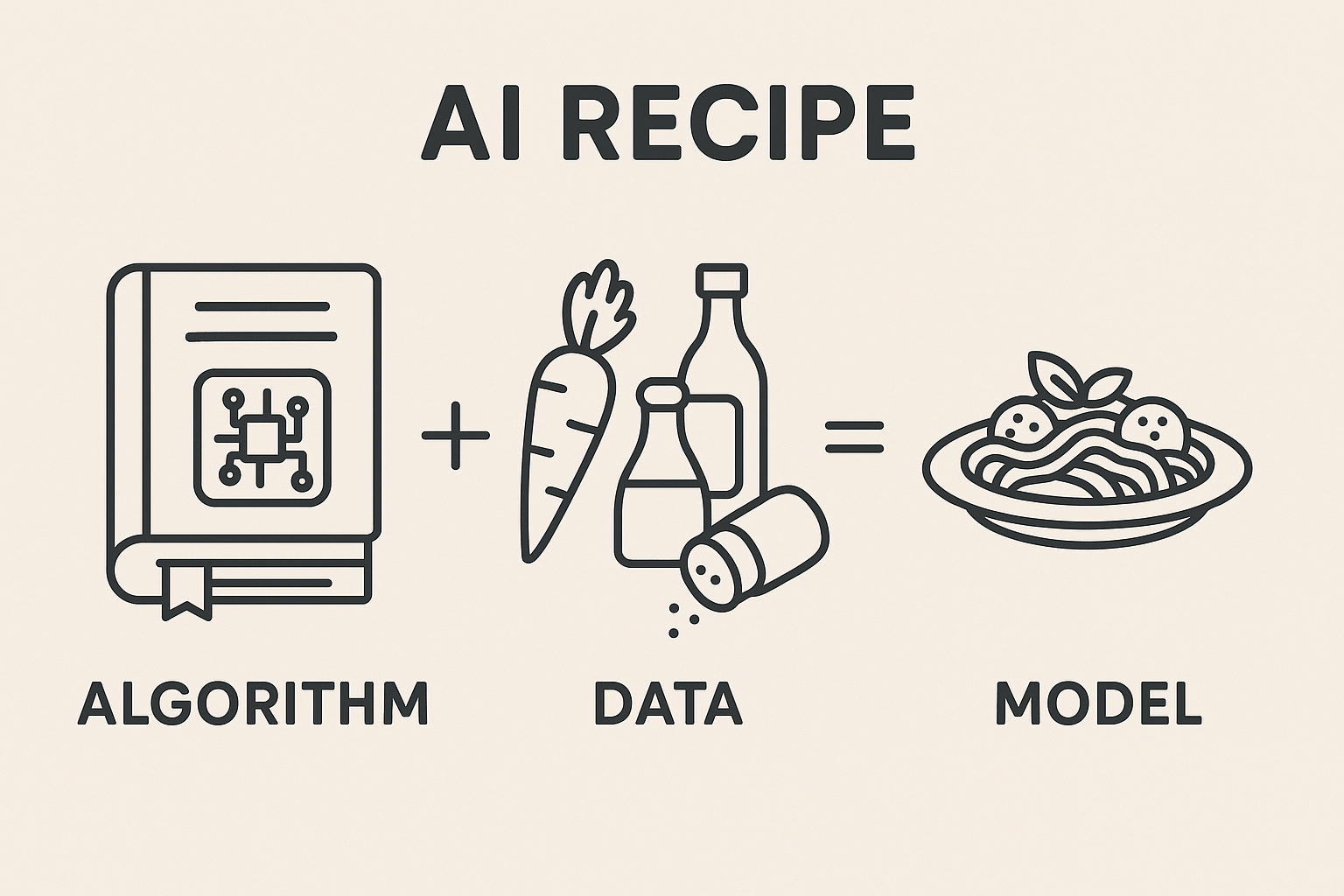
- Algorithms: The Recipe Book of AI
These step-by-step instructions guide the execution of specific tasks, solving problems while continuously learning from the data they process.
- Data: The Raw Ingredients
In the context of AI, data refers to the information that algorithms use to learn and make decisions (the ingredients for our recipe). This data can be in various forms, such as text, images, audio, or numerical values. AI systems analyze this data to identify patterns, make predictions, and improve their performance over time.
We have structured data - Databases, spreadsheets or CSV files, and unstructured data such as emails, social media posts, content from websites.
The quality, quantity and variety of the data (ingredients) can drastically influence the outcome.
- Model: The final dish
The model is the finished dish that results from following the algorithm (recipe) and processing the data (ingredients). Just as a well-prepared dish showcases the flavours and textures of its ingredients, a trained AI model reflects the patterns and insights derived from the data. The quality and effectiveness of the model depend on the precision of the algorithm and the richness of the data used.
🎯 Focus for SMEs: Todays AI can be described as Narrow or Weak AI. These are tools designed for one specific task but do it very well. Think:
* Chatbots handling customer FAQs.
* Software predicting which sales leads are most likely to convert.
* Tools analysing customer reviews for common themes.
* Voice recognition tools like Alexa or OK Google (which SMEs can already leverage indirectly via voice search optimisation).
These are the accessible, affordable starting points bringing real benefits to SMEs today.
Beyond Narrow AI: Understanding Artificial General Intelligence (AGI) and Artificial Superintelligence (ASI)
While the practical AI tools available to SMEs today are forms of 'Narrow AI', it's helpful to understand the broader concepts often discussed in relation to AI's future: Artificial General Intelligence (AGI) and Artificial Superintelligence (ASI).
- Artificial General Intelligence (AGI): Imagine AI with human-like cognitive abilities – the capacity to understand, learn, and apply knowledge across a wide range of tasks, much like a human can switch between calculating sums, understanding language, and learning a new game. Unlike Narrow AI, which excels at one thing, AGI would possess broad intellectual capabilities. AGI is currently theoretical and remains largely in the realm of research; it's not something you can buy or implement today.
- Artificial Superintelligence (ASI): This is a hypothetical form of intellect that would far surpass the brightest human minds in virtually every field, from scientific creativity to general wisdom. The concept often follows discussions of AGI – the idea being that once AGI is achieved, it might rapidly improve itself, potentially leading to Superintelligence. This is highly speculative and involves complex ethical and existential questions debated by futurists and researchers.
Why This Matters (and Doesn't) for Your SME:
Understanding these concepts helps place the AI tools you can use today into perspective. AGI and ASI are not relevant to the practical, day-to-day AI tools SMEs are using now. The purpose of knowing these terms is simply for context, helping you navigate broader conversations about AI's potential long-term trajectory. A lot of the hype and noise around AI is often talk about AGI and ASI.
For your SME, the focus remains firmly on leveraging practical Narrow AI to solve real business problems, improve efficiency, and enhance customer service.
🛠️ 2. How AI Learns (And Why You Don’t Need to Be a Techie)
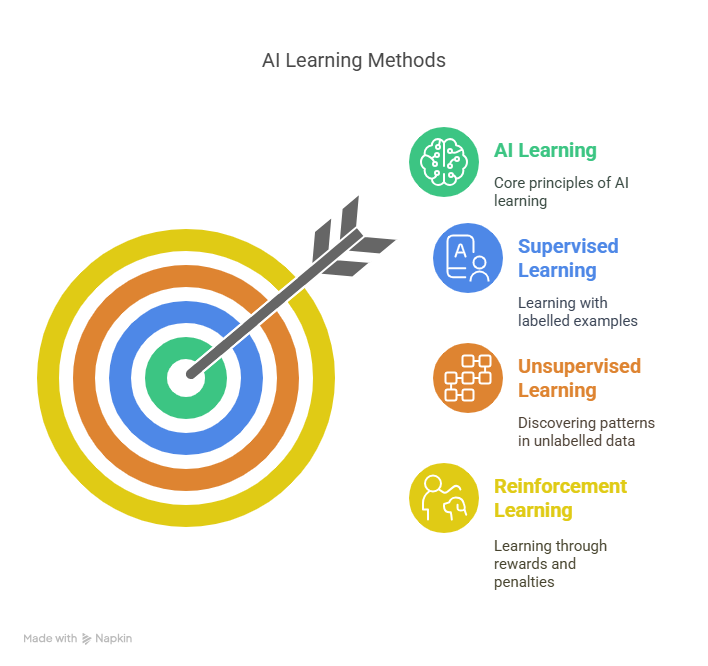
Understanding the basic principles helps you choose the right tools, but you don't need a computer science degree! AI learns in a few key ways:
- Supervised Learning: This is like teaching a child with flashcards. You show the AI examples that are already labelled correctly (e.g., emails marked "spam" or "not spam," customer data labelled "likely to churn" or "not likely"). AI learns the patterns to make predictions on new, unseen data.
- SME Relevance: Powers many predictive tools, like sales forecasting, spam filters, and identifying potentially faulty products from images.
- Unsupervised Learning: This is like asking someone to sort a big box of mixed Lego bricks without instructions they might sort them by shape, size colours. The AI looks for hidden patterns and structures within unlabelled data on its own.
- SME Relevance: Great for discovering insights you didn't know existed, like grouping customers into distinct segments based on purchasing behaviour, identifying unusual transactions that could signal fraud, or finding natural clusters in survey responses.
- Reinforcement Learning: Think of training a dog with treats. The AI learns by trial and error, receiving 'rewards' (+1) for good actions and 'penalties' (-1) for bad ones, gradually figuring out the best strategy to achieve a goal.
- SME Relevance: Used in more dynamic situations like optimising delivery routes, adjusting pricing in real-time, inventory mangement or controlling automated machinery.
🚀 3. Real AI Tools SMEs Are Using Right Now
AI is here; it's embedded in affordable, practical tools SMEs across the UK are already using to punch above their weight. Here’s a look at common applications:
Customer Service:
- AI Chatbots: Handling frequently asked questions 24/7, qualifying leads, scheduling appointments, freeing up human agents for complex issues. (Look for tools integrating with your website/social media).
Content & Communication:
- Large Language Models (LLMs) like ChatGPT, Claude and Gemini: Drafting emails, generating marketing copy, summarizing reports, brainstorming ideas, translating languages, improving internal documentation. (Crucial: Always review and edit AI-generated content).
Operations & Production:
- Computer Vision: Monitoring inventory levels via cameras, performing visual quality control checks on products, enhancing security systems by identifying anomalies.
Marketing & Sales:
- Voice Search Optimisation: Ensuring your website and content are easily found when customers use voice assistants (increasingly important for local businesses).
- Predictive Analytics: Forecasting sales trends, identifying high-value leads, predicting customer churn.
- Sentiment Analysis (via Natural Language Processing - NLP): Analysing customer reviews, social media mentions, or survey responses to understand overall satisfaction and identify specific pain points.
Admin & Data Management:
- NLP for Document Processing: Extracting key information from invoices or contracts, sorting and tagging documents automatically, analysing large volumes of text-based feedback.
🎙️ Listen in: In our latest podcast episode, Demystifying AI for SMEs
⚠️ 4. The Challenges (And How to Manage Them Like a Pro)
AI is powerful, but it's not a magic wand. It comes with potential pitfalls that SMEs need to manage proactively:
- Bias and Fairness: AI learns from data as we discussed earlier. If that data reflects historical biases (e.g., biased hiring practices in past data), the AI can perpetuate or even amplify them.
- Management: Be aware of the data used to train your AI tools. Question vendor claims about fairness. Look for biases in AI outputs, especially in sensitive areas like HR or customer segmentation.
- AI “Hallucinations” & Accuracy: Sometimes, AI models (especially LLMs) generate incorrect, misleading, or completely fabricated information, but present it confidently.
- Management: Never blindly trust AI output. Always fact-check critical information generated by AI. Use it as a draft-generator or assistant, not the final authority.
- Data Privacy and Security: AI tools often require access to sensitive customer or business data. This raises significant GDPR and data protection concerns.
- Management: Understand what data the AI uses, where it's stored, and who has access. Choose vendors with strong security credentials and clear privacy policies (see Section 7). Ensure your use complies with UK regulations.
- Over-Reliance and Deskilling: Relying too heavily on AI without understanding its limitations can lead to errors being missed. There's also a risk of staff losing skills if AI completely takes over certain tasks.
- Management: Use AI to augment human skills, not entirely replace them. Focus on automating repetitive parts of tasks, leaving judgement and complex decision-making to humans. Encourage critical evaluation of AI suggestions.
- Integration and Implementation Costs: While many tools are affordable, integrating them smoothly with your existing systems and training staff can require time and investment.
- Management: Start small (see Section 5). Choose tools known for easy integration. Factor in training time and potential consultancy costs if needed.
✅ Golden Rule: Always keep a "human in the loop". AI should support human decision-making, not replace it entirely, especially for critical or nuanced tasks. Regular review and oversight are essential.
🧭 5. Your 3-Step AI Action Plan
Feeling ready to explore AI but unsure where to begin? Start small, stay focused, and follow this simple plan:
Phase 1: Assess & Identify Opportunities (Weeks 1-2)
Don't jump at the shiniest new AI tool. First, understand your own business needs:
- ✔ Identify Pain Points: What tasks are repetitive, time-consuming, or prone to human error? Where are your biggest bottlenecks? (e.g., manually answering the same customer queries, struggling to analyse sales data quickly).
- ✔ Review Your Data: What data do you already collect? (Customer details, sales figures, website analytics, production logs, etc.). Is it accessible and reasonably organised? Good data is fuel for AI.
- ✔ Brainstorm Potential AI Wins: Based on your pain points and data, where could an AI tool realistically help? Refer back to Section 3 for ideas. Focus on areas with clear potential for saving time, reducing costs, or improving quality/service.
Phase 2: Pilot a Low-Risk Project (Month 1-3)
Choose one promising opportunity and test a specific AI tool on a small scale. Aim for a quick win:
- Select a Tool: Choose an affordable, user-friendly tool addressing your chosen pain point (see Section 6). Prioritise tools with free trials or low entry costs.
- Define Success: How will you know if the pilot is working? Set clear, measurable goals before you start (e.g., "Reduce response time for FAQs by 50%", "Identify 10% more qualified leads per week", "Save 5 hours of admin time per month").
- Run the Test: Implement the tool in a controlled way. Perhaps test an internal chatbot first, or use an AI writing assistant for internal drafts only. Involve a small group of staff.
Examples of Good Pilot Projects:
* Implementing a simple website chatbot for out-of-hours queries.
* Using an LLM to help draft social media posts or email templates.
* Trying an AI-powered tool to analyse website traffic patterns for insights.
* Testing software that extracts data from scanned invoices automatically.
Phase 3: Evaluate, Learn & Scale (Ongoing)
Once your pilot period is over, review the results objectively:
- Measure Against KPIs: Did you meet the goals you set? Analyse the quantitative data (time saved, costs reduced, leads generated) and qualitative feedback (staff experience, ease of use).
- Gather Feedback: Talk to the staff involved and customers if applicable. What worked well? What were the challenges? Was the tool easy to use?
- Decide Next Steps:
- Success? Gradually expand the use of the tool, train more staff, and integrate it further into your workflow.
- Mixed Results? Can the process be iterating? Is more training needed? Or was it the wrong tool/problem? Learn from the experience.
- Failure? Don't be discouraged! Understand why it didn't work and return to Phase 1 with new insights.
- Expand Confidently: Once you have a successful pilot under your belt, you can start identifying and piloting other AI applications with greater confidence.
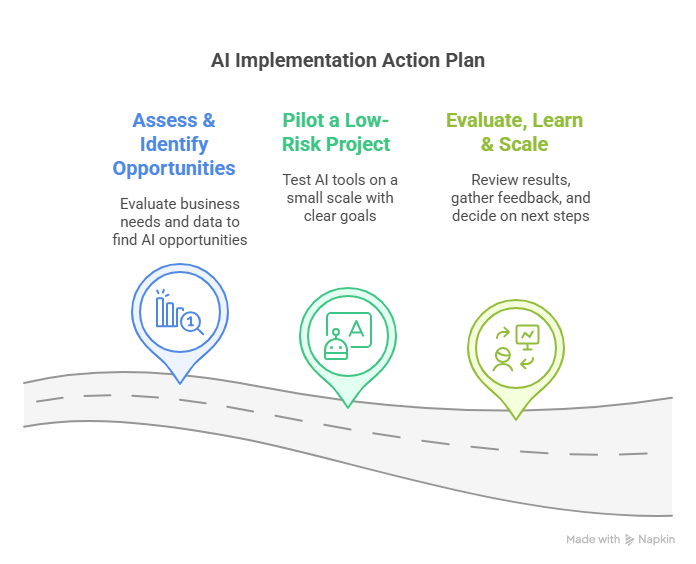
📦 6. Choosing the Right AI Tools
The market is flooded with AI solutions. Don't get distracted by flashy features; focus on what provides tangible value for your SME:
- Start with the Problem, Not the Tool: Clearly define the business challenge you're trying to solve before you start looking at vendors.
- Prioritise User-Friendliness: Look for tools with intuitive interfaces and a low learning curve. Can your existing team realistically use this without extensive technical training?
- Check Vendor Reputation and Support: Read reviews, look for case studies (especially from other UK SMEs), and understand the level of customer support offered. Is support available during UK business hours?
- Verify Data Privacy and Security: This is non-negotiable. Ensure the vendor is GDPR compliant and clearly explains how your data is handled, stored, and protected. Ask where the data servers are located.
- Assess Integration Capabilities: Will the tool work smoothly with your existing software (CRM, accounting software, website platform, etc.)? Poor integration can create more work than it saves.
- Consider Scalability: Can the tool grow with your business? What happens if your usage increases? Understand the pricing tiers.
- Don't Ignore the ROI: Set clear goals and measure the Return on Investment. Remember ROI isn't just about direct revenue increase. Factor in:
- Time saved for your staff (allowing them to focus on higher-value tasks).
- Cost reductions (e.g., reduced waste, lower support overheads).
- Improved customer satisfaction and retention.
- Enhanced decision-making quality.
- Improved employee morale (by automating tedious tasks).
🎯 Tip: Create a simple checklist or comparison matrix when evaluating different tools against your specific needs and criteria.
🛡️ 7. Know the Rules: AI and UK Regulations
Using AI, especially tools handling personal data, means navigating important regulations. Staying compliant isn't just good practice; it's a legal necessity.
- General Data Protection Regulation (GDPR) & UK Data Protection Act 2018: These are the cornerstones. If your AI processes personal data (of customers, employees, etc.), you must comply. Key principles include:
- Lawfulness, Fairness, and Transparency: Be clear about how you use AI and why.
- Purpose Limitation: Only use data for the specific, legitimate purpose you collected it for.
- Data Minimisation: Only process the data necessary for the task.
- Accuracy: Ensure data is accurate and up-to-date.
- Storage Limitation: Don't keep data longer than necessary.
- Integrity and Confidentiality: Protect data through appropriate security measures.
- Accountability: You must be able to demonstrate compliance.
- UK's AI Regulatory Approach (as of 2025): The UK government is pursuing a "pro-innovation," context-specific approach, relying on existing regulators (like the Information Commissioner's Office (ICO), Competition and Markets Authority (CMA), etc.) to apply principles like safety, transparency, fairness, accountability, and redress within their sectors. There isn't one single "UK AI Act" like the EU's, but the principles are crucial. Keep an eye on guidance from the ICO and relevant industry bodies.
- EU AI Act: While the UK isn't bound by it directly, if you operate in the EU, use EU-based AI tools, or if it sets international standards, it's important to be aware of its risk-based framework (high-risk AI systems face stricter rules).
- Transparency and Explainability: Increasingly important, especially if AI makes significant decisions about individuals (e.g., loan applications, job shortlisting). You should be able to explain, at least broadly, how the AI reached its decision.
👀 Key Actions:
* Vendor Due Diligence: Ask potential AI vendors about their compliance measures.
* Data Protection Impact Assessments (DPIAs): Consider conducting a DPIA if implementing AI that involves high-risk processing of personal data.
* Update Privacy Policies: Ensure your policies reflect your use of AI tools.
* Staff Training: Make sure staff using AI tools understand their data protection responsibilities.
Fairness, transparency, and accountability aren't just legal tick-boxes; they build trust with your customers and staff.
📈 🔮 9. What’s Next? The SME AI Landscape in 2025
The AI landscape evolves rapidly, but the trend for SMEs in 2025 is clear: greater accessibility and practicality. Here’s what’s happening now and what to prepare for:
- More Budget-Friendly, SME-Focused Tools: Vendors are increasingly recognising the SME market. Expect more AI solutions specifically designed with SME budgets, workflows, and technical expertise levels in mind (often subscription-based).
- Rise of No-Code/Low-Code AI Platforms: These platforms allow non-technical staff to build or customise simple AI workflows using drag-and-drop interfaces, democratising AI implementation further.
- Integrated AI Across Business Functions: AI won't just live in isolated departments. Expect tools that connect data and provide insights across sales, marketing, operations, and customer service for a more holistic business view (e.g., AI analysing CRM data and support tickets to predict churn).
- AI Agents for Task Automation: Simple AI "agents" capable of performing multi-step tasks based on instructions (e.g., "research competitors' pricing for product X and summarise findings in a report") will become more common and useful for automating routine workflows.
The key takeaway for 2025: AI is becoming less of a specialist tool and more of a standard business enabler, integrated into the software SMEs already use.
✅ 10. Final Thoughts: AI is Here to Help, Not Hinder
Navigating the world of AI might seem daunting, but the core message for UK SMEs in 2025 is one of opportunity, not overwhelm.
You don’t need to become an AI expert or hire a team of data scientists overnight. You just need to be curious, identify where AI can solve your specific business problems, and take that first step.
AI, when used thoughtfully, is a powerful lever to help your SME:
- Work Smarter, Not Harder: Automate the mundane, freeing up your valuable time and your team's talent for strategic thinking, creativity, and customer relationships.
- Make Data-Driven Decisions: Gain insights from your business data that were previously hidden or too time-consuming to uncover.
- Enhance Customer Experiences: Provide faster responses, more personalised interactions, and smoother service.
- Level the Playing Field: Access capabilities previously only available to larger corporations, allowing you to compete more effectively.
The key is to start small, focus on clear benefits, and always keep your business goals and human oversight central to the process.
Ready to begin your AI journey?
🎧 Tune In Now: Listen to our Podcast Series The SME AI Hub or subscribe to our future Blog Post where we will continue our SME AI journey.
